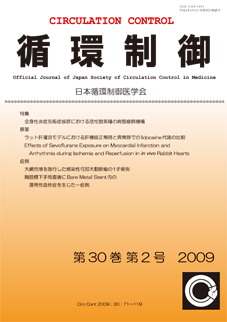All issues

Volume 30 (2009)
- Issue 3 Pages 165-
- Issue 2 Pages 82-
- Issue 1 Pages 8-
Volume 30, Issue 2
Displaying 1-4 of 4 articles from this issue
- |<
- <
- 1
- >
- >|
original articles
-
Noriko Suzaki, Maiko Sadamatsu, Tomohiro Katagami, Yuko Soga, Takaaki ...2009Volume 30Issue 2 Pages 82-87
Published: 2009
Released on J-STAGE: May 31, 2013
JOURNAL FREE ACCESSLidocaine(LID), an antiarrhythmic agent, is used as a first-line agent for acute severe ventricular arrhythmias. LID is often used emergently without assessment of liver function. We examined the pharmacokinetic parameters of LID and monoethylglycinexylidide(MEGX) in normal- and dys-function of liver using the perfused rat liver. The liver function was normal range within 30 minutes of starting perfusion, but hepatic dysfunction was appeared at 150 minutes after starting perfusion. So we used LID(3mg/kg) at 30 and 150 minutes of starting perfusion. AUCMEGX is significantly increased at 150 minutes, except for AUCLID, CLLID, and CLMEGX. These results showed the possibility that the elimination of MEGX may be delayed in hepatic dysfunction. And it is suggested that LID can be injected with the same dose in normal- and dys-function of liver.View full abstractDownload PDF (324K) -
Hisashi Beppu, Uno Imaizumi, Munetaka Furuya, Kazutoshi Higuchi, Hitos ...2009Volume 30Issue 2 Pages 88-94
Published: 2009
Released on J-STAGE: May 31, 2013
JOURNAL FREE ACCESSThe effects of sevoflurane on myocardial ischemia and reperfusion injury have not been well studied, especially in in vivo model. The present study aimed to investigate the effect of timing and duration of sevoflurane exposure on the intensity of myocardial response, and ischemia/reperfusion arrhythmias.
All anesthetized open-chest rabbits underwent 30 min of left anterior descending coronary artery(LAD) occlusion followed by 3 hrs of reperfusion. In the control group(C), and sevoflurane group(S), rabbits were subjected to 30 min of LAD occlusion and 3 hrs of reperfusion under ketamine/xylazine(k/x) or sevoflurane anesthesia respectively. The ischemia-preconditioned rabbits underwent 5 min of LAD occlusion followed by 10 min of reperfusion under k/x anesthesia(C-IP), or sevoflurane(S-IP). In the sevoflurane-preconditioned group(C-SP), 30 min of sevoflurane exposure at a 1.5% end-tidal concentration was followed by 15 min of washout before 30 min of LAD occlusion and 3 hrs of reperfusion under k/x anesthesia. At the end of 3-hrs reperfusion period, area at risk was delineated by Evans blue and infarct size determined by triphenyltetrazolium chloride(TTC) staining. The rate pressure product did not alter significantly at any point among all the groups. Compared with group C, myocardial protective effect was observed in groups of S, C-IP, S-IP and C-SP. However, infarct size in sevoflurane-preconditioned group was significantly larger than those of S and S-IP groups. Also, infarct limiting effect of S-IP group was significantly intensified compared with C-IP and S. Continuous exposure of sevoflurane reduced arrhythmias during not only ischemia but reperfusion period in rabbit hearts.
These results suggested that continuous sevoflurane exposure might confer additive infarct limiting effect on ischemic preconditioning. We found that ischemic preconditioning and sevoflurane preconditioning do not have anti-arrhythmic effect, though sevoflurane exposure has anti-arrhythmic effects against ischemia and reperfusion-induced arrhythmia.View full abstractDownload PDF (251K)
case reports
-
Syuichi Okada, Tatsuo Kaneko, Masahiko Ezure, Yasushi Sato, Yutaka Has ...2009Volume 30Issue 2 Pages 95-99
Published: 2009
Released on J-STAGE: May 31, 2013
JOURNAL FREE ACCESSA 56-year-old female was admitted to a hospital due to fever and back pain. She was diagnosed of asthmatic bronchitis and received antibiotic therapy. But two weeks later she complained of back pain again. Her white blood cells and C-reactive protein(CRP) were elevated and computed tomography(CT) revealed aortic arch aneurysm. Two weeks later, she was referred to our hospital. CT revealed rapid enlargement of the aneurysm. She was diagnosed of mycotic descending aortic aneurysm and underwent resection of the aneurysm and in situ prosthetic graft replacement and omentopexy around the graft. She received antibiotic therapy until the day 52 postoperatively. Their postoperative courses were good and no recurrence of infection was seen.View full abstractDownload PDF (529K) -
Takahiro Futatsuki, Tamotsu Kuniyoshi, Sumikazu Isowaki, Etsurou Nagat ...2009Volume 30Issue 2 Pages 100-104
Published: 2009
Released on J-STAGE: May 31, 2013
JOURNAL FREE ACCESSWe report a case of late stent thrombosis in the immediate postoperative period of non-cardiac surgery four weeks after a bare metal stent(BMS) implantation. A 77-year old man who was scheduled for thoracoscopic mediastinal lymph node biopsy received preoperatively implantation of BMS for significant stenosis in the proximal left anterior descending coronary artery. The surgery was postponed four weeks after the stent insertion and the dual anti-platelet therapy with aspirin and ticropidine was discontinued one week before the surgery. The surgery was successfully performed under general anesthesia even with episodes of bradycardia and hypotension.
Immediately after the surgery, ST-segment elevation in left precordial leads and acute heart failure appeared following a complete atrioventricular block. An emergency coronary angiogram revealed a thrombotic stenosis of the BMS and a restenting restored the stent patency and its hemodynamics.
In this case, one of the most important factors causing the stent thrombosis must be discontinuation of antiplatelets. It is very difficult to decide whether to continue antiplatelets or not, because the risk of bleeding or stent thrombosis depends on the type of surgery, stent, and antiplatelets and the time between the stenting and the surgery. Therefore, the issues as stated above should be discussed cautiously among the anesthesiologist, surgeon, and treatment physician.View full abstractDownload PDF (375K)
- |<
- <
- 1
- >
- >|